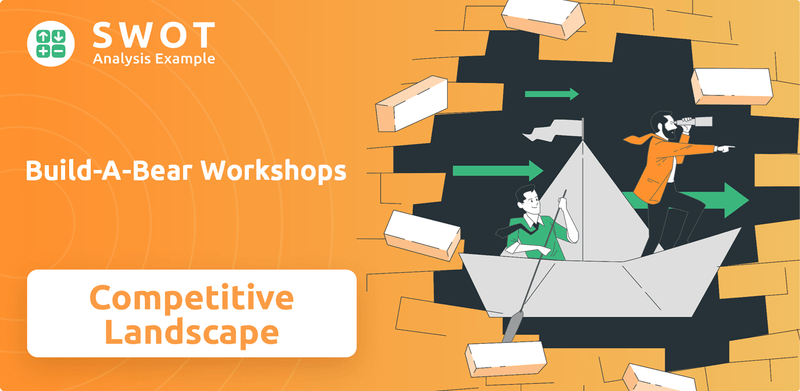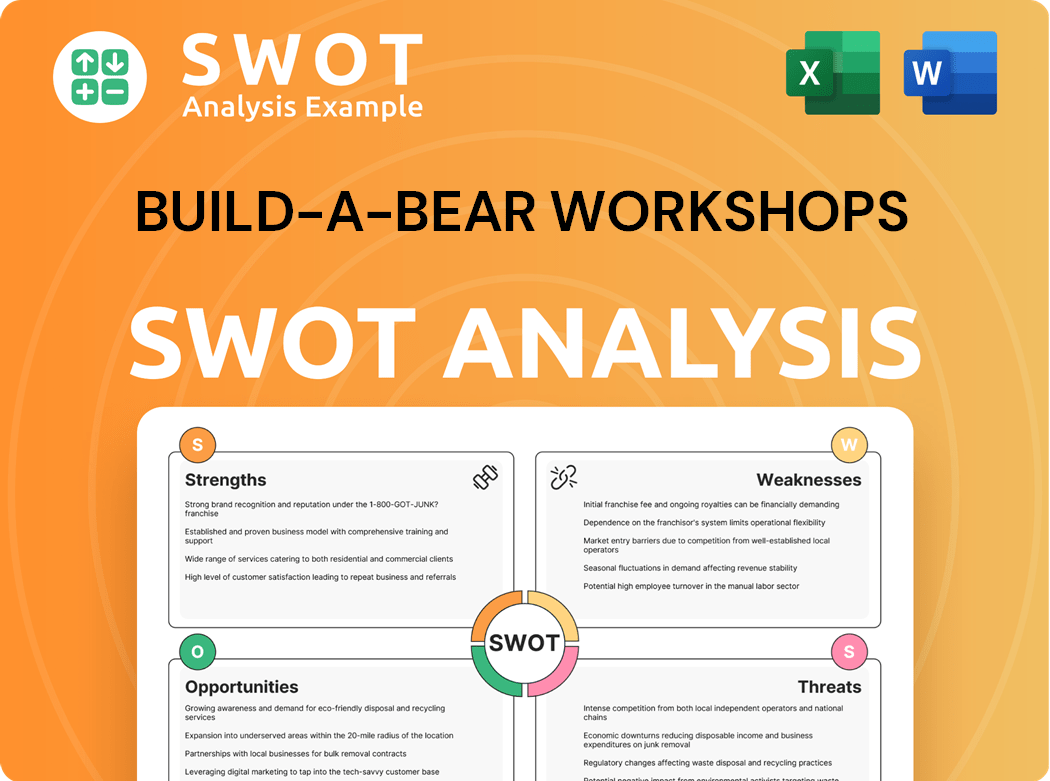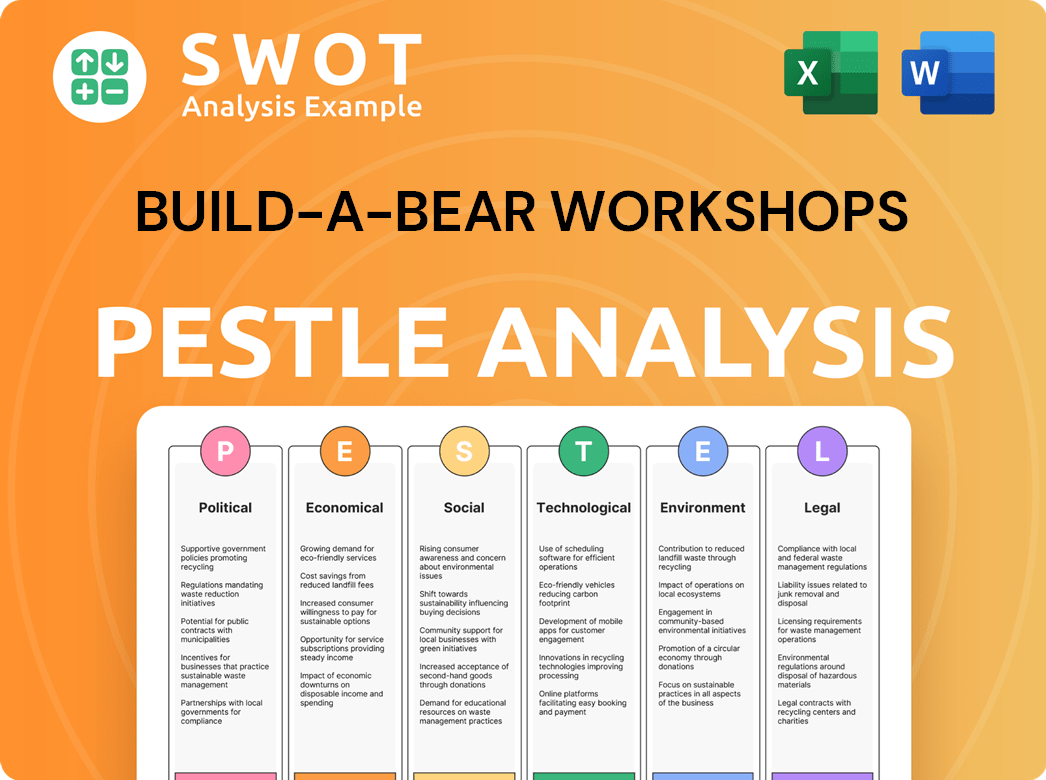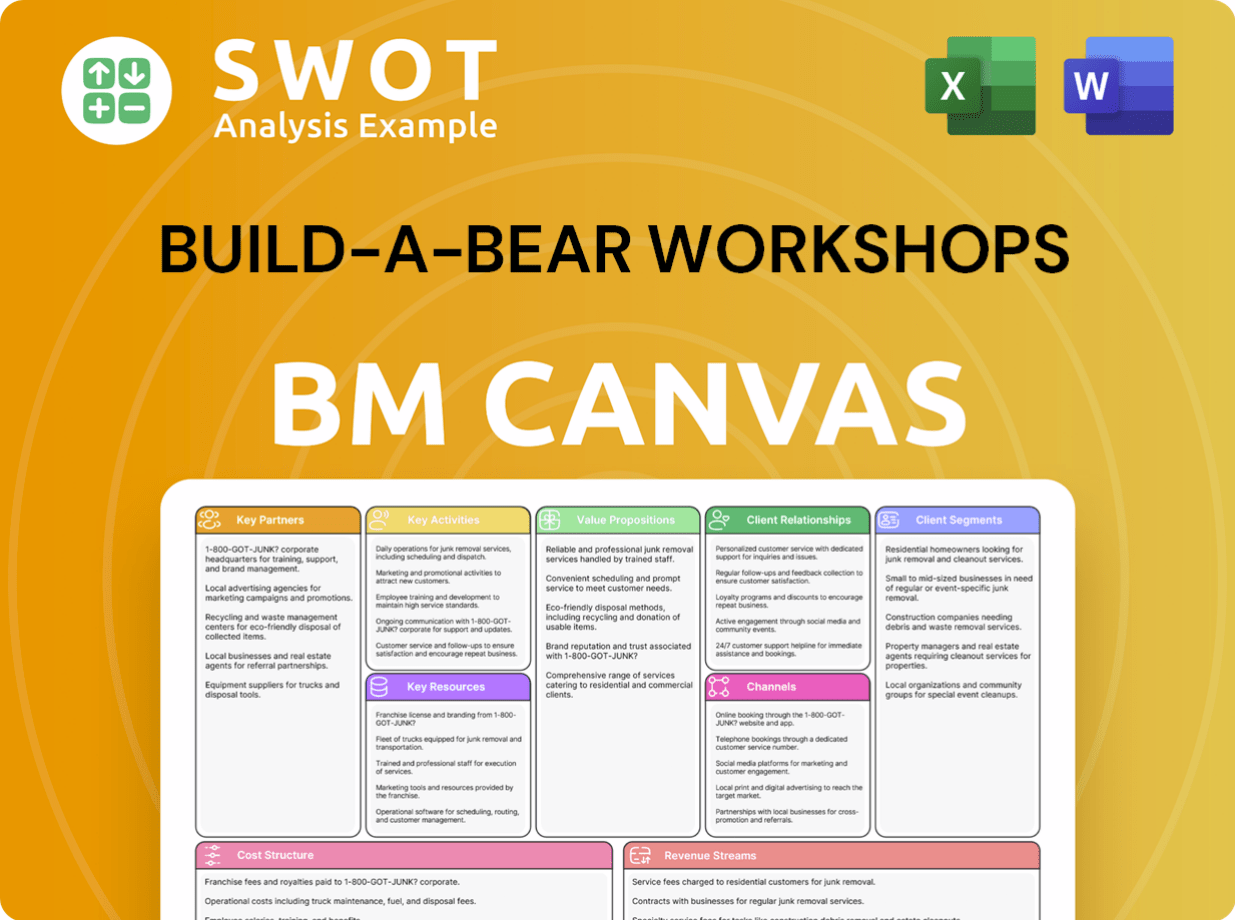Build-A-Bear Workshops Bundle
How Does Build-A-Bear Workshop Thrive in a Competitive Market?
The Build-A-Bear Workshops SWOT Analysis reveals a fascinating story of adaptation and resilience in the ever-changing toy retail market. Founded in 1997, this company revolutionized the industry with its interactive, personalized approach to stuffed animals. But how has Build-A-Bear maintained its market position amidst fierce competition and evolving consumer trends?

This analysis delves into the Build-A-Bear competitive landscape, exploring its key rivals and the strategies that allow it to stand out. We'll examine the Build-A-Bear business model, its market share analysis, and how it differentiates itself from competitors in the Build-A-Bear industry. Understanding Build-A-Bear's competitive advantages is crucial for anyone seeking insights into the toy retail market and the company's future growth prospects.
Where Does Build-A-Bear Workshops’ Stand in the Current Market?
Within the realm of specialty retail and entertainment, Build-A-Bear Workshop holds a distinctive market position, primarily focusing on families and children. The company's core operations revolve around offering an interactive experience where customers can create personalized stuffed animals. This involves selecting, stuffing, personalizing, and naming their creations, complemented by a wide array of outfits and accessories.
The value proposition of Build-A-Bear lies in its experiential retail model, which provides a unique and engaging activity for its target audience. This model fosters emotional connections with customers, driving brand loyalty and repeat visits. The company's ability to blend retail with entertainment is a key differentiator in the toy retail market.
As of early 2024, Build-A-Bear operated approximately 350 company-owned stores across the United States, Canada, the United Kingdom, and Ireland, along with an additional 60 franchised stores internationally. This widespread presence, often in high-traffic areas, provides broad accessibility. The company has expanded into digital gaming and content, demonstrating a commitment to digital transformation.
Build-A-Bear is widely recognized as the dominant player in the 'create-your-own' plush toy segment. Although specific market share figures are not readily available in broad industry reports, its brand recognition and unique offerings solidify its leadership. This strong position is crucial in the Build-A-Bear competitive landscape.
The company's global presence includes a significant number of company-owned and franchised stores. These locations are strategically placed in high-traffic areas, ensuring broad accessibility for its target customers. This widespread presence is critical for its market analysis.
For the fiscal year ending February 3, 2024, Build-A-Bear reported total revenues of $488.7 million. Additionally, the company reported a net income of $33.4 million for the same period. These figures indicate a healthy financial standing within its specialized market segment, which is important for understanding Build-A-Bear's financial performance compared to competitors.
Build-A-Bear has strategically broadened its appeal beyond children to include teens and adults. This expansion, combined with enhanced digital platforms, increases accessibility and engagement. The company's ability to adapt its target market is a key factor in its long-term success.
Build-A-Bear differentiates itself through its unique experiential retail model and strong brand recognition. This model fosters emotional connections with customers, driving brand loyalty. Its competitive advantages include a well-established brand and a loyal customer base.
- Experiential Retail: The in-store experience is a core part of its business model, setting it apart from traditional toy retailers.
- Brand Loyalty: The personalized nature of the product and the in-store experience fosters strong customer loyalty.
- Strategic Adaptations: The company's ability to adapt to changing market trends, including digital transformation, is a key strength.
- Global Presence: A widespread physical footprint in key markets provides broad accessibility to its target customer segments.
Build-A-Bear Workshops SWOT Analysis
- Complete SWOT Breakdown
- Fully Customizable
- Editable in Excel & Word
- Professional Formatting
- Investor-Ready Format

Who Are the Main Competitors Challenging Build-A-Bear Workshops?
The Build-A-Bear competitive landscape is shaped by a mix of direct and indirect rivals across the retail, toy, and entertainment sectors. While direct competitors offering similar 'create-your-own' experiences are limited, indirect competition is fierce, posing significant challenges to the company's market position. Understanding these competitors is crucial for analyzing Build-A-Bear's market share and developing effective competitive strategies.
The Build-A-Bear industry faces constant pressure from traditional toy retailers, online giants, and companies specializing in licensed merchandise. These competitors often leverage competitive pricing, vast selections, and strong brand recognition to attract consumers. The dynamic nature of the toy retail market requires Build-A-Bear to continually innovate and adapt to maintain its competitive edge.
Direct competitors are limited due to Build-A-Bear's unique 'create-your-own' experience. Smaller, independent toy stores or craft businesses that offer similar personalized product creation may exist, but on a much smaller scale.
Traditional toy retailers like Toys 'R' Us, Walmart, and Target pose a significant threat. They offer vast selections of plush toys and licensed merchandise at competitive prices. These retailers often have established customer bases and extensive marketing capabilities.
Online retailers, especially Amazon, are major competitors due to convenience, vast selection, and competitive pricing. The shift to online shopping necessitates that Build-A-Bear continually enhance its e-commerce capabilities.
Companies specializing in licensed merchandise, such as Disney Store and Universal Studios retail, compete for consumer spending. They leverage strong intellectual property and marketing campaigns to attract customers.
The entertainment sector, including theme parks and arcades, also competes for discretionary spending. New entrants in the experiential retail space could emerge as future challengers.
Ongoing mergers and acquisitions among toy companies and retailers further shape market dynamics. Build-A-Bear must adapt to these changes to maintain its competitive position.
Build-A-Bear's competitive advantages include its unique in-store experience, customization options, and strong brand recognition. However, it faces challenges from competitors with lower prices and broader product selections. Here are some key factors:
- Pricing Strategy: Competitors like Walmart and Amazon often offer lower prices on similar products, requiring Build-A-Bear to justify its premium pricing through the value of its in-store experience and customization.
- Product Selection: While Build-A-Bear specializes in plush animals, competitors offer a wider range of toys, potentially attracting a broader customer base.
- Online Presence: Build-A-Bear's e-commerce capabilities must compete effectively with established online retailers like Amazon, which offer convenience and extensive product catalogs.
- Customer Experience: Build-A-Bear's in-store experience is a key differentiator, but competitors are also investing in enhancing their customer experiences to attract and retain customers.
- Marketing and Brand Recognition: Competitors with strong marketing budgets and established brands can attract customers more easily. Build-A-Bear needs to maintain its brand visibility and marketing efforts.
Build-A-Bear Workshops PESTLE Analysis
- Covers All 6 PESTLE Categories
- No Research Needed – Save Hours of Work
- Built by Experts, Trusted by Consultants
- Instant Download, Ready to Use
- 100% Editable, Fully Customizable

What Gives Build-A-Bear Workshops a Competitive Edge Over Its Rivals?
The competitive advantages of Build-A-Bear Workshop are primarily rooted in its unique experiential retail model, strong brand equity, and strategic licensing partnerships. These factors collectively contribute to its ability to differentiate itself within the toy retail market. Understanding the Build-A-Bear competitive landscape requires a deep dive into these core strengths and how they translate into market performance.
Build-A-Bear's interactive, customizable process of creating a stuffed animal is a key differentiator. This hands-on experience, where customers participate in the stuffing, dressing, and naming of their plush toy, fosters a strong emotional connection and a sense of ownership. This personalized approach enhances customer loyalty and creates memorable experiences, encouraging repeat visits and word-of-mouth marketing, which is crucial in the Build-A-Bear industry.
Brand equity is another crucial advantage. Over more than two decades, Build-A-Bear has cultivated a widely recognized and trusted brand, particularly among families. This strong brand presence translates into a loyal customer base and a perception of quality and fun. The company leverages this equity through consistent branding across its physical stores, online platforms, and marketing campaigns. To learn more about the company's ownership and financial strategies, you can explore Owners & Shareholders of Build-A-Bear Workshops.
Build-A-Bear's interactive model, where customers customize stuffed animals, sets it apart. This hands-on experience fosters emotional connections and loyalty. The model encourages repeat visits and positive word-of-mouth, crucial for its success.
The company has built a strong brand over two decades, recognized and trusted by families. This brand recognition translates into a loyal customer base. Consistent branding across stores, online platforms, and marketing campaigns reinforces this equity.
Collaborations with popular entertainment franchises, like Disney and Marvel, attract a broader audience. These partnerships tap into established fan bases, driving sales. Licensed products keep the brand relevant in pop culture.
Licensing agreements provide a significant edge, offering plush versions of beloved characters. These collaborations generate substantial sales and buzz. Effective marketing of these licenses enhances product appeal.
Build-A-Bear's competitive advantages are multifaceted, including its experiential retail model, strong brand equity, and strategic licensing partnerships. These elements work together to create a unique and engaging customer experience, fostering loyalty and driving sales. The company's ability to adapt and innovate within the toy retail market is crucial for sustained success.
- Experiential Retail: The hands-on customization process creates emotional connections and encourages repeat visits.
- Brand Recognition: Over two decades of brand-building have resulted in a loyal customer base.
- Licensing Power: Partnerships with major entertainment franchises drive sales and keep the brand relevant.
- Customer Loyalty: Personalized experiences and quality products build strong customer relationships.
Build-A-Bear Workshops Business Model Canvas
- Complete 9-Block Business Model Canvas
- Effortlessly Communicate Your Business Strategy
- Investor-Ready BMC Format
- 100% Editable and Customizable
- Clear and Structured Layout

What Industry Trends Are Reshaping Build-A-Bear Workshops’s Competitive Landscape?
The toy retail market and the broader specialty retail sector are undergoing significant transformations, directly impacting the competitive landscape for companies like Build-A-Bear Workshop. Understanding these shifts is crucial for assessing its future prospects. The company's ability to adapt to these trends will be key to maintaining and growing its market position.
The company faces both challenges and opportunities shaped by consumer behavior, technological advancements, and economic conditions. The following analysis explores these dynamics, offering insights into the strategies required for sustainable growth within the evolving Build-A-Bear competitive landscape.
Several key trends are reshaping the toy retail market. E-commerce and digital engagement are increasingly important, with consumers expecting seamless online shopping experiences. There's also a growing demand for sustainable and ethically produced products, along with a preference for personalized and unique items. These trends present both challenges and opportunities for the company.
Future challenges include potential economic downturns affecting discretionary spending and intense competition from mass-market retailers and online giants. The rising costs of labor and materials could also pressure profit margins. Maintaining the novelty of its experiential model and adapting to changing consumer preferences are also significant hurdles.
Significant opportunities exist in expanding into emerging international markets and further diversifying into digital content, such as games or animated series. Strategic partnerships beyond traditional licensing could also broaden its reach. The company can leverage its unique business model to capitalize on the demand for personalized experiences.
To remain resilient, the company is likely to continue its focus on omnichannel retail, integrating physical stores with robust e-commerce and digital engagement. Exploring new product categories and expanding its global footprint are also crucial. These adaptations will help it navigate the evolving market dynamics.
The company's success hinges on several key strategies. These include enhancing the online shopping experience, expanding digital product offerings, and emphasizing sustainable practices. Further customization options and exploring new ways for customers to express individuality are also vital. These efforts can help the company maintain a competitive edge in the toy retail market.
- Omnichannel Retail: Integrating physical stores with e-commerce for a seamless customer experience. The company's e-commerce sales reached $118.8 million in fiscal year 2023, showing the importance of this strategy.
- Product Diversification: Exploring new product categories and digital content to expand revenue streams.
- Global Expansion: Targeting emerging international markets to increase market share.
- Sustainability Focus: Emphasizing sustainable materials and ethical manufacturing to appeal to conscious consumers.
- Personalization: Enhancing customization options to meet consumer demand for unique products.
Build-A-Bear Workshops Porter's Five Forces Analysis
- Covers All 5 Competitive Forces in Detail
- Structured for Consultants, Students, and Founders
- 100% Editable in Microsoft Word & Excel
- Instant Digital Download – Use Immediately
- Compatible with Mac & PC – Fully Unlocked

Related Blogs
- What are Mission Vision & Core Values of Build-A-Bear Workshops Company?
- What is Growth Strategy and Future Prospects of Build-A-Bear Workshops Company?
- How Does Build-A-Bear Workshops Company Work?
- What is Sales and Marketing Strategy of Build-A-Bear Workshops Company?
- What is Brief History of Build-A-Bear Workshops Company?
- Who Owns Build-A-Bear Workshops Company?
- What is Customer Demographics and Target Market of Build-A-Bear Workshops Company?
Disclaimer
All information, articles, and product details provided on this website are for general informational and educational purposes only. We do not claim any ownership over, nor do we intend to infringe upon, any trademarks, copyrights, logos, brand names, or other intellectual property mentioned or depicted on this site. Such intellectual property remains the property of its respective owners, and any references here are made solely for identification or informational purposes, without implying any affiliation, endorsement, or partnership.
We make no representations or warranties, express or implied, regarding the accuracy, completeness, or suitability of any content or products presented. Nothing on this website should be construed as legal, tax, investment, financial, medical, or other professional advice. In addition, no part of this site—including articles or product references—constitutes a solicitation, recommendation, endorsement, advertisement, or offer to buy or sell any securities, franchises, or other financial instruments, particularly in jurisdictions where such activity would be unlawful.
All content is of a general nature and may not address the specific circumstances of any individual or entity. It is not a substitute for professional advice or services. Any actions you take based on the information provided here are strictly at your own risk. You accept full responsibility for any decisions or outcomes arising from your use of this website and agree to release us from any liability in connection with your use of, or reliance upon, the content or products found herein.